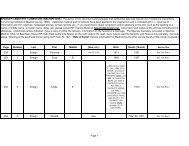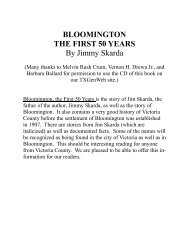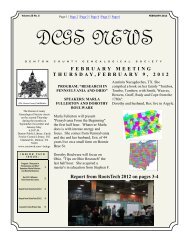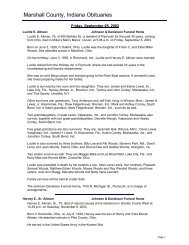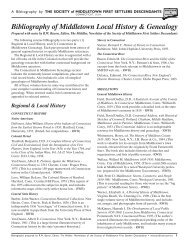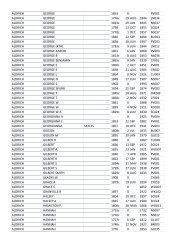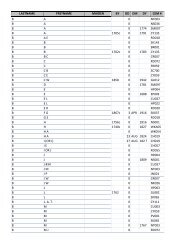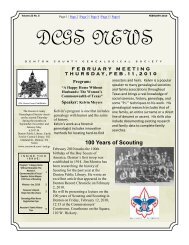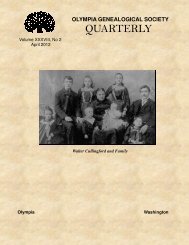Getting to the Roots of Your Family - RootsWeb - Ancestry.com
Getting to the Roots of Your Family - RootsWeb - Ancestry.com
Getting to the Roots of Your Family - RootsWeb - Ancestry.com
Create successful ePaper yourself
Turn your PDF publications into a flip-book with our unique Google optimized e-Paper software.
ABBREVIATIONS<br />
Abbreviations are used <strong>of</strong>ten and indicated in many different ways. Some <strong>of</strong> <strong>the</strong><br />
indications <strong>of</strong> abbreviation are:<br />
• raised letters<br />
• colon, semi-colon, period<br />
• straight line drawn above <strong>the</strong> word, a line through <strong>the</strong> ascender <strong>of</strong> a letter<br />
• a curvy line above <strong>the</strong> word or at <strong>the</strong> end <strong>of</strong> <strong>the</strong> word<br />
• almost any word starting with <strong>the</strong> letter “p”<br />
raised letter “th” curl back line on <strong>to</strong>p “pf”<br />
DATES<br />
It is important <strong>to</strong> remember <strong>the</strong> following as you deal with dates in <strong>the</strong> records:<br />
• Before 1752 <strong>the</strong> calendar year was from March 25 th <strong>to</strong> March 24 th . In 1752 <strong>the</strong><br />
beginning <strong>of</strong> <strong>the</strong> year was changed <strong>to</strong> January 1 st .<br />
• Sometimes you will find dates written as follows: 7 ber or 7 br , 8 ber , 9 ber , 10 ber .<br />
These are abbreviations for <strong>the</strong> months <strong>of</strong> <strong>the</strong> year <strong>of</strong> September (7ber), Oc<strong>to</strong>ber<br />
(8ber), November (9ber), and December (10ber).<br />
• Dates in <strong>the</strong> records are <strong>of</strong>ten written in Roman Numerals: I (1), II (2), V (5), VI<br />
(6), X (10), L (50), C (100), D (500), M (1000).<br />
• A “j” is used <strong>to</strong> represent <strong>the</strong> end <strong>of</strong> a series <strong>of</strong> numbers. It is a “1” and<br />
sometimes <strong>the</strong> series <strong>of</strong> numbers is just a “1”.<br />
• At times <strong>the</strong> date will be given as a Saint Day such as Michaelmas, ra<strong>the</strong>r than a<br />
month and day. A good British research reference book or a “Google” search can<br />
be used <strong>to</strong> locate <strong>the</strong> Saint’s Days.<br />
• The year might be given as <strong>the</strong> year <strong>of</strong> <strong>the</strong> reign <strong>of</strong> a king or queen such as in <strong>the</strong><br />
10 th year <strong>of</strong> <strong>the</strong> reign <strong>of</strong> Queen Elizabeth.<br />
LATIN<br />
Before 1733 many <strong>of</strong> <strong>the</strong> records are in Latin.<br />
• It is possible by learning a few basic genealogical terms in Latin <strong>to</strong> read <strong>the</strong><br />
records enough <strong>to</strong> get <strong>the</strong> genealogical information from <strong>the</strong>m.



